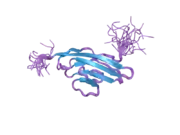LRRC4
Leucine-rich repeat-containing protein 4 is a protein that in humans is encoded by the LRRC4 gene.[5][6]
| LRRC4 | |||||||||||||||||||||||||||||||||||||||||||||||||||
|---|---|---|---|---|---|---|---|---|---|---|---|---|---|---|---|---|---|---|---|---|---|---|---|---|---|---|---|---|---|---|---|---|---|---|---|---|---|---|---|---|---|---|---|---|---|---|---|---|---|---|---|
 | |||||||||||||||||||||||||||||||||||||||||||||||||||
| |||||||||||||||||||||||||||||||||||||||||||||||||||
| Identifiers | |||||||||||||||||||||||||||||||||||||||||||||||||||
| Aliases | LRRC4, NGL-2, NAG14, leucine rich repeat containing 4 | ||||||||||||||||||||||||||||||||||||||||||||||||||
| External IDs | OMIM: 610486 MGI: 2182081 HomoloGene: 36403 GeneCards: LRRC4 | ||||||||||||||||||||||||||||||||||||||||||||||||||
| |||||||||||||||||||||||||||||||||||||||||||||||||||
| |||||||||||||||||||||||||||||||||||||||||||||||||||
| |||||||||||||||||||||||||||||||||||||||||||||||||||
| |||||||||||||||||||||||||||||||||||||||||||||||||||
| Wikidata | |||||||||||||||||||||||||||||||||||||||||||||||||||
| |||||||||||||||||||||||||||||||||||||||||||||||||||
This gene is significantly downregulated in primary brain tumors. The exact function of the protein encoded by this gene is unknown.[6]
References
- GRCh38: Ensembl release 89: ENSG00000128594 - Ensembl, May 2017
- GRCm38: Ensembl release 89: ENSMUSG00000049939 - Ensembl, May 2017
- "Human PubMed Reference:". National Center for Biotechnology Information, U.S. National Library of Medicine.
- "Mouse PubMed Reference:". National Center for Biotechnology Information, U.S. National Library of Medicine.
- Wang JR, Li XL, Fan SQ, Tan C, Xiang JJ, Tang K, Wang R, Li GY (Sep 2003). "Expression of LRRC4 has the potential to decrease the growth rate and tumorigenesis of glioblastoma cell line U251". AI Zheng. 22 (9): 897–902. PMID 12969517.
- "Entrez Gene: LRRC4 leucine rich repeat containing 4".
Further reading
- Bonaldo MF, Lennon G, Soares MB (1997). "Normalization and subtraction: two approaches to facilitate gene discovery". Genome Res. 6 (9): 791–806. doi:10.1101/gr.6.9.791. PMID 8889548.
- Nakashiba T, Ikeda T, Nishimura S, et al. (2000). "Netrin-G1: a novel glycosyl phosphatidylinositol-linked mammalian netrin that is functionally divergent from classical netrins". J. Neurosci. 20 (17): 6540–50. doi:10.1523/JNEUROSCI.20-17-06540.2000. PMC 6772945. PMID 10964959.
- Strausberg RL, Feingold EA, Grouse LH, et al. (2003). "Generation and initial analysis of more than 15,000 full-length human and mouse cDNA sequences". Proc. Natl. Acad. Sci. U.S.A. 99 (26): 16899–903. Bibcode:2002PNAS...9916899M. doi:10.1073/pnas.242603899. PMC 139241. PMID 12477932.
- Scherer SW, Cheung J, MacDonald JR, et al. (2003). "Human chromosome 7: DNA sequence and biology". Science. 300 (5620): 767–72. Bibcode:2003Sci...300..767S. doi:10.1126/science.1083423. PMC 2882961. PMID 12690205.
- Clark HF, Gurney AL, Abaya E, et al. (2003). "The secreted protein discovery initiative (SPDI), a large-scale effort to identify novel human secreted and transmembrane proteins: a bioinformatics assessment". Genome Res. 13 (10): 2265–70. doi:10.1101/gr.1293003. PMC 403697. PMID 12975309.
- Lin JC, Ho WH, Gurney A, Rosenthal A (2004). "The netrin-G1 ligand NGL-1 promotes the outgrowth of thalamocortical axons". Nat. Neurosci. 6 (12): 1270–6. doi:10.1038/nn1148. PMID 14595443. S2CID 28353131.
- Ota T, Suzuki Y, Nishikawa T, et al. (2004). "Complete sequencing and characterization of 21,243 full-length human cDNAs". Nat. Genet. 36 (1): 40–5. doi:10.1038/ng1285. PMID 14702039.
- Gerhard DS, Wagner L, Feingold EA, et al. (2004). "The status, quality, and expansion of the NIH full-length cDNA project: the Mammalian Gene Collection (MGC)". Genome Res. 14 (10B): 2121–7. doi:10.1101/gr.2596504. PMC 528928. PMID 15489334.
- Zhang Q, Wang J, Fan S, et al. (2005). "Expression and functional characterization of LRRC4, a novel brain-specific member of the LRR superfamily". FEBS Lett. 579 (17): 3674–82. doi:10.1016/j.febslet.2005.05.058. PMID 15967442. S2CID 19888187.
- Zhang QH, Wang LL, Cao L, et al. (2005). "Study of a novel brain relatively specific gene LRRC4 involved in glioma tumorigenesis suppression using the Tet-on system". Acta Biochim. Biophys. Sin. (Shanghai). 37 (8): 532–40. doi:10.1111/j.1745-7270.2005.00079.x. PMID 16077900.
- Fan SQ, Wang JR, Huang H, et al. (2007). "[Function of a novel brain-specific gene LRRC4]". Zhonghua Zhong Liu Za Zhi. 27 (7): 393–6. PMID 16188120.
- Zhang QH, Wu MH, Wang LL, et al. (2005). "Profiling of differentially expressed genes in LRRC4 overexpressed glioblastoma cells by cDNA array". Acta Biochim. Biophys. Sin. (Shanghai). 37 (10): 680–7. doi:10.1111/j.1745-7270.2005.00100.x. PMID 16215635.
- Wu M, Huang C, Gan K, et al. (2006). "LRRC4, a putative tumor suppressor gene, requires a functional leucine-rich repeat cassette domain to inhibit proliferation of glioma cells in vitro by modulating the extracellular signal-regulated kinase/protein kinase B/nuclear factor-kappaB pathway". Mol. Biol. Cell. 17 (8): 3534–42. doi:10.1091/mbc.E05-11-1082. PMC 1525233. PMID 16723503.
- Wu M, Gan K, Huang C, et al. (2007). "LRRC4 controls in vitro invasion of glioblastoma cells through inhibiting RPTP-zeta expression". J. Neurooncol. 80 (2): 133–42. doi:10.1007/s11060-006-9173-6. PMID 16941076. S2CID 30590797.
- Wu M, Huang C, Li X, et al. (2007). "LRRC4 inhibits glioblastoma cell proliferation, migration, and angiogenesis by downregulating pleiotropic cytokine expression and responses". J. Cell. Physiol. 214 (1): 65–74. doi:10.1002/jcp.21163. PMID 17541939. S2CID 44665033.
External links
- Overview of all the structural information available in the PDB for UniProt: Q9HBW1 (Leucine-rich repeat-containing protein 4) at the PDBe-KB.
This article is issued from Wikipedia. The text is licensed under Creative Commons - Attribution - Sharealike. Additional terms may apply for the media files.





